Throughout the last couple of months AMD has been in the process of carefully and deliberately rolling out their latest generation of video cards. In a multi-staged process we have seen AMD engage in a what is best described as a drawn-out teaser and an early technical briefing, announcing their intention to roll out a new high-end video card this quarter, further teasing the public with pictures of the card, and then in the middle of all of that giving the technical press an in-depth briefing on AMD’s key next-generation memory technology, High Bandwidth Memory. While AMD did their best to make sure the details of the cards were kept under wraps – with varying results – AMD definitely wanted to make sure the world would know that their card was coming.

Catching up to the present, earlier this week AMD held their 2015 GPU product showcase, dubbed “The New Era of PC Gaming.” As the latest stage in AMD’s master plan, AMD held a public event in Los Angeles similar to their 2014 GPU product showcase in Hawaii, where the company announced their product lineup ahead of the full launch of the products in question. In the presentation we learned some (but not all) of the details surrounding AMD’s Radeon 300 series, including the numbered products from 360 to 390, and of course the company’s new high-end flagship video card, the Radeon R9 Fury X.
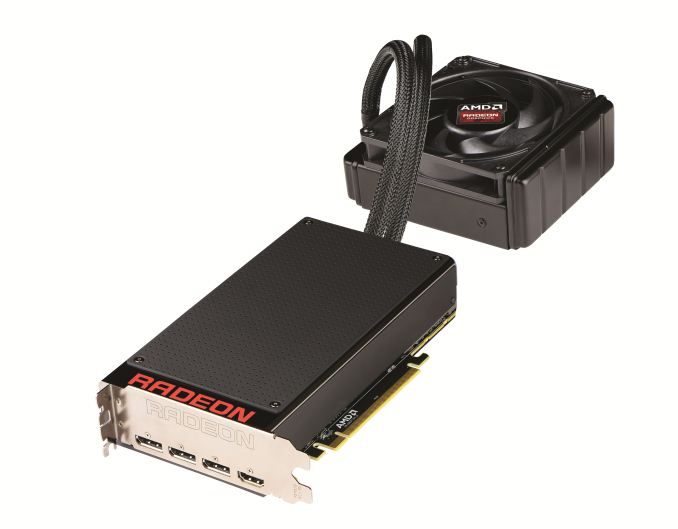 All told the showcase itself was something of a teaser itself – we got prices, but not complete specifications – but we also received confirmation of AMD’s rollout plans. The next stage, coinciding with today’s article, is the formal launch of the numbered members of the Radeon 300 series, which are product refreshes based on existing AMD GPUs, similar to what we saw with the 200 series in 2013. Meanwhile today is also the greater unveiling (but not the launch) of the Fury series, with AMD allowing us to share more details about the new card and its specifications. Following today’s announcements and launches, the Radeon R9 Fury X will be launching in just under a week from now, on June 24th, and then after that the R9 Fury (vanilla) will be launching on July 14th.
All told the showcase itself was something of a teaser itself – we got prices, but not complete specifications – but we also received confirmation of AMD’s rollout plans. The next stage, coinciding with today’s article, is the formal launch of the numbered members of the Radeon 300 series, which are product refreshes based on existing AMD GPUs, similar to what we saw with the 200 series in 2013. Meanwhile today is also the greater unveiling (but not the launch) of the Fury series, with AMD allowing us to share more details about the new card and its specifications. Following today’s announcements and launches, the Radeon R9 Fury X will be launching in just under a week from now, on June 24th, and then after that the R9 Fury (vanilla) will be launching on July 14th.
Overall AMD is launching an almost top-to-bottom refresh of its product lineup overnight. Between now and July 14th the company and its partners will introduce cards from $109 to $649, and while there are a few gaps that AMD is almost certainly purposely leaving in place to give them something to announce later this year, overall we’re seeing more or less AMD’s entire hand for 2015 and early 2016 in one go.
As for the subjects at hand today, there are really two stories to talk about. The first is of course the Radeon R9 Fury series, the products that will house AMD’s newest flagship GPU, Fiji. While I won’t butter up Fiji from an architectural standpoint at this time, what Fiji does bring to the table are two very big changes for AMD. The first of these is of course high bandwidth memory, which not only gives AMD more VRAM bandwidth than ever before, but it outright changes how GPUs video cards are constructed. The second big change is that Fiji is just very big. At 596mm2 AMD went right to the reticle limit, putting AMD squarely into the big GPU race.
But before Fury comes the rest of the 300 series. We'll take a look at Fury in due time - while we've been briefed on the subject and have been authorized to discuss it, we want to hold back for when we have the hardware in hand - so our focus for today will be on what's launching today, and that's the Radeon 300 series.
Being released today are five new cards from AMD’s partners, which will form the backbone of the Radeon 300 series from $109 to $429. To our regular readers these parts will be familiar – and to some, perhaps more familiar than they’d like – while for AMD the 300 series represents their 3rd generation of retail 28nm products.
Radeon R7 360, R7 370, & R9 380
Launching today is the bulk of the Radeon 300 series, the so-called “numbered” parts like 390, which are categorically distinct from the Fury products. As we mentioned in the introduction, from a volume standpoint these cards are the backbone of AMD’s lineup and will be where the majority of their sales take place. The attention may be on Fiji as AMD’s newest and fastest part, but it’s here where AMD makes the most in sales.
To cut right to the chase then, for better or worse all of the numbered parts – 360, 370, 380, and the 390 series – are refresh products based on existing AMD GPUs. The only new GPU AMD is launching for desktop video cards is Fiji for the Fury parts, which leads us to the current situation.
Since the launch of the original GCN 1.0 cards in 2012, AMD has gone about refreshing their lineup in an unusual piecemeal fashion. All-told AMD has launched three new desktop GPUs in the last two years – Bonaire, Hawaii, and Tonga – and next week Fiji will make number 4. So AMD hasn’t stayed idle since 2012, but because they’re releasing 1-2 GPUs a year each year, they none the less end up releasing refresh products such as is the case with the 300 series.
| AMD Radeon Product Evolution | |||||
| Predecessor | GPU | Successor | |||
| Radeon R9 290X | Hawaii | Radeon R9 390X | |||
| Radeon R9 285 | Tonga | Radeon R9 380 | |||
| Radeon R9 265 Radeon HD 7850 | Pitcairn | Radeon R9 370 | |||
| Radeon R9 260 | Bonaire | Radeon R9 360 | |||
Along these lines, because AMD is not releasing new GPUs in this range, the company is also forgoing releasing reference cards. Reference cards were built for testing/promotional purposes, but all of the cards being launched today will be fully-custom cards tailored to the 300 series specifications, a number of which will be similar to existing 200 series cards. This means AMD’s partners are offering a significant variety of cards right off the bat, a pure virtual launch, as it is sometimes called.
However because AMD isn’t producing any retail reference cards they have also opted to not pre-sample the press ahead of time for reviews. And while we’ll be looking at partner cards over the coming weeks, for today’s launch we do not have any cards or benchmarks in hand, and for the immediate future our focus is going to be on Fury.
So with that out of the way, let’s get started on AMD’s new Radeon 300 series lineup, starting from the bottom and working our way up.
At the bottom of the 300 series stack is the R7 360. This is a cut-down Bonaire based card featuring 12 of Bonaire’s 14 CUs active, for a total of 768 SPs. This part is essentially the replacement for the R7 260, which was similarly a cut-down Bonaire based part.
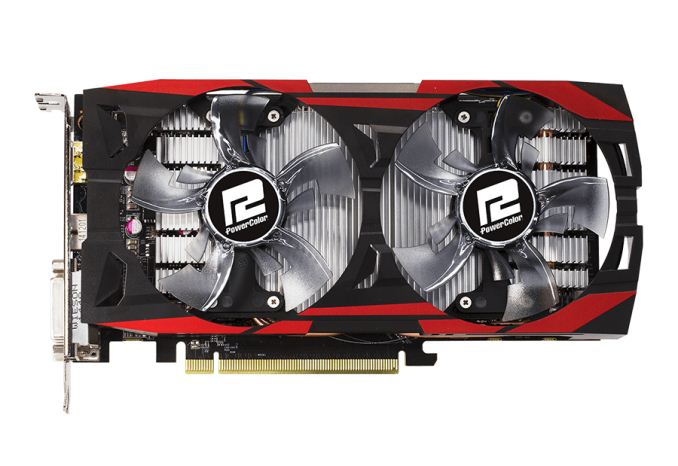
Like the other refresh cards in the 300 series, the R7 360 pushes the envelope just a bit harder to offer an incremental improvement in performance over its predecessor. AMD has turned up the GPU and memory clockspeeds slightly, from 1000MHz/6Gbps on R7 260 to 1050MHz/6.5Gbps on R7 360. Both the GPU and memory clockspeeds essentially close in on the gap between this card and AMD’s top tier Bonaire card, R7 260X, so everything here is within what we’ve seen the best of Bonaire designs do before.
At a typical board power (TBP) of 100W, R7 360 is spec’d to draw just a bit more power than its predecessor, in line with its clockspeed increases. Meanwhile AMD is telling us that we should see cards with 2GB of VRAM, and from the product lists I’ve seen in advance I’m expecting that this will be the default, at-MSRP configuration for this product. And with an MSRP of $109, it will be a drop-in replacement for the R7 260 from an MSRP standpoint.
Finally, as AMD’s entry-level video card, expect to see AMD targeting this at budget buyers and/or MOBA/F2P gamers. Both AMD and NVIDIA are well aware of how much money DOTA2, League of Legends, and other games within that space have been able to pull in, and they want a piece of that pie themselves. All of these games are designed to be able to run decently on iGPUs, so the company’s marketing focus is on being able to play these games at higher framerates with better image quality.
Up next is the Radeon R7 370. Based on AMD’s venerable Pitcairn GPU, this card is essentially a rework of the R7 265, AMD’s sole cut-down 16 CU (1024 SP) Pitcairn card in the 200 series.
Compared to the R7 265, the R7 370 sees a 5% GPU clockspeed bump, up from the R7 265’s 925MHz boost clock to an “engine clock” (and what we’re assuming is a boost clock) for the R7 370 of 975MHz. Meanwhile memory speeds remain unchanged at 5.6Gbps, which after AMD’s Pitcairn board rework for the 200 series, is about as much as Pitcairn’s memory controllers are up to the task of driving.
Perhaps the most interesting change here is that AMD’s official TBP is spec’d for 110W; this is sharply lower than the official 150W TBP for the R7 265. Truth be told I question whether this number is grounded in reality – even with some hearty BIOS-level optimizations, that’s a 26% reduction – but we’ll have to see what the retail cards are like once we can get our hands on them.
The big issue for R7 370 right now is that Pitcairn is venerable, but it’s also old. It’s the one GCN 1.0 GPU in the 300 series, and that means it lacks all of the feature updates and optimizations that have come since then. Consequently compared to newer products it doesn’t feature fine-grained clockspeed domains, support for Freesync or True Audio, support for decoding any video over 1080p, nor does it possess performance optimizations like delta color compression.
Pitcairn continues to be a workhorse for AMD in large part because it does its job so well, but the differences between it and the newer GCN GPUs become more readily apparent with each generation. Along with lacking Freesync support, it’s also the only GPU in the 300 series lineup not to support DirectX 12 feature level 12_0 (instead it’s an 11_1 part), so while none of these feature deficits are deal-breakers, it does none the less highlight the fact that like the workhorses that have come before it (e.g. G92), Pitcairn is on its last generation.
Anyhow, AMD’s specifications call for the R7 370 to be offered with both 2GB and 4GB configurations. Based on the early pricing we’ve seen, it looks like the 2GB card will be the common configuration, with 4GB being an option, though less likely. Expect to see 2GB cards hit the market at $149, the same price as the R7 265 before it, with 4GB pricing around $169.
Going up the ladder once more, we have the R9 380. This card is based on AMD’s Tonga GPU, their first GCN 1.2 GPU, and is the descendant of the R9 285, which was launched back in September.
Like the other cards in today’s launch, the R9 380 has seen a spec bump compared to its predecessor. The boost clock is up by about 6% from 918MHz to 970MHz, and the memory clock is unchanged, holding at 5.5Gbps. No other changes have been made, and the other specifications such as the number of CUs (28), the number of ROPs.(32), and the number of memory controllers (4) remains identical to R9 285.
Update 06/18: We have since corrected the memory clocks for the R9 380. AMD's marketing material lists two different values; 5.5Gbps and 5.7Gbps. The original guide we based our information on listed just 5.7, so that is the original value we used. As we always list the minimum specifications for a product, we have corrected this to 5.5Gbps. Our apologies for the confusion.
Unfortunately this also means that we’ll be waiting for another day to see what a fully-enabled Tonga would be like. AMD has to date not shipped a fully enabled chip; it has since become clear that Tonga does in fact have 6 memory controllers (for a 384-bit bus) as opposed to the 4 we see active here, and on the desktop in particular we’ve never seen a part with all 32 CUs (2048 SPs) enabled. The closest thing to a full Tonga remains the R9 M295X in the Apple iMac. Despite being the oldest of the GCN 1.2 chips, Tonga for now also remains the most mysterious.
Moving on, compared to the R9 285 the TBP of the R9 380 holds at 190W. Whatever power optimizations AMD has been able to make have essentially been consumed by the clockspeed increases. In the 300 series lineup this makes the R9 380 AMD’s premiere sub-225W card, as these cards can be driven by a pair of 6-pin connectors, or on more forward-looking models a single 8-pin connector.
As far as memory configurations and pricing goes, like the other 300 series cards, R9 380 gets an optional memory bump. The base MSRP of $199 is for the 2GB card, while you can expect to see 4GB cards for $219-$229 or so. Since AMD’s partners are also offering 4GB R7 370s, a 4GB R9 380 is not all that surprising, and it gives buyers an option for a card that's going to be a little more future-proof than a 2GB card in 2015.
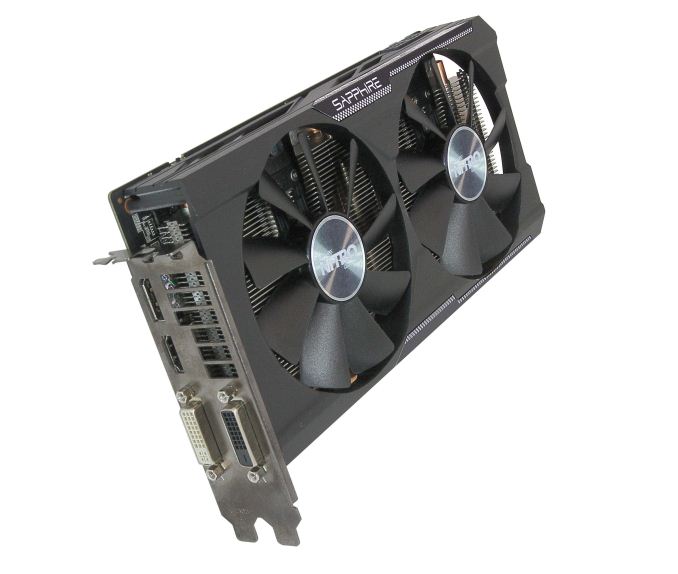
Finally, expect to see AMD pitch the R9 380 as a 1440p card. While we haven’t benchmarked this card yet, based on what we’ve seen with the R9 285, I’m expecting similar results. In which case like the R9 285, AMD is likely overshooting in their expectations. In 2015 Tonga is a good GPU for 1080p gaming, but even with 4GB I’m not sure the performance is there to keep 1440p with high quality settings playable over the next 2-3 years.
Overall it’s interesting to note that of the first 3 300 series cards, all of them ended up being close (if not identical) to the 300 series OEM cards AMD quietly launched back at the start of May. The 360 and 370 are identical, whereas the retail 380 is clocked a bit higher relative to its OEM counterpart. So for anyone who was expecting the retail cards to be similar to the OEM cards, they were right in this case. Though the upside here at least is that the OEM cards don’t significantly deviate from the retail cards, which is a great relief given what we’ve seen in some of the previous generations.
But like the OEM cards, this also means that there are some obvious gaps in AMD’s current lineup from a hardware standpoint. None of these first 3 parts utilizes a fully-enabled GPU; each and every card uses a cut-down GPU of some kind. From a pricing standpoint this is likely a good thing for AMD and its partners since it ensures clear tiers of cards, but when we have single-card entries this is also typically done with fully-enabled GPUs, not cut-down GPUs. If we don’t eventually see X cards for some of these series I will be shocked, but then again we never did get a R9 285X…
In any case, this means that the coexistence of the 200 and 300 series will be an odd one to begin with. Along with the generally lower pricing of the 200 series, you can find fully-enabled Pitcairn and Bonaire cards there that don’t yet exist in the 300 series lineup, so the relative performance of the two series is a bit of a mess for the moment.
Radeon R9 390 Series: Return To Hawaii
Last but not least among the numbered 300 series stack are the top two cards and the only cards not to exist in some form in the OEM lineup, the R9 390 and R9 390X. These two cards are based on AMD’s Hawaii GPU, previously used for the R9 290 series, and of all of the cards in this refresh, these cards may very well attract the most interest for a couple of different reasons.
The first reason is simply because as AMD’s former flagship GPU, it was Hawaii and the 290 series that took the brunt of the blow from the launch of NVIDIA’s Maxwell 2 architecture launch in 2014. NVIDIA undercut AMD on price while beating them at performance and acoustics, which put AMD in a difficult situation. And since AMD is not replacing Hawaii with another chip at this performance level any time soon, this means that Hawaii is what AMD has available to throw at the sub-Fury market.
Meanwhile the other factor at play here is that AMD significantly cut 290 series prices in the months since the Maxwell 2 launch to recover from the situation and improve the competitive positioning of the products since they lacked the performance edge. This led to prices around $319 and $249 for the R9 290X and R9 290 as recently as the GTX 980 Ti launch, for example. However with the 300 series, AMD now wants to get card prices up to $429 and $329 respectively, which means that AMD needs to be able to do something special to justify a price hike of $100. Short of RAM and NAND flash memory, where cyclical commodity pressure leads to gluts and shortages of supplies, driving up the cost of existing computer components is very difficult to do, so how AMD is going to achieve this is of great interest.
Anyhow, without further ado, let’s take a look at AMD’s plans for the R9 390 series.
As with the 290 series, the 390 series is split between two cards, with the difference coming down to clockspeeds and the number of CUs enabled. R9 390X and R9 390 are direct successors to R9 290 and R9 290X in this respect, with the former being a higher clocked part with all 44 CUs (2816 SPs) enabled, while the latter is lower clocked with 40 CUs (2560 SPs) enabled.
The biggest change from a specifications perspective is that AMD has cranked up both the GPU and memory clockspeeds in order to further improve performance. With partners already regularly offering higher-end factory overclocked cards with boost clockspeeds at 1050MHz (or more) for the R9 290X, AMD has essentially crafted a new SKU from this mark for the 390X. Meanwhile the R9 390 sees its boost clockspeed go from 947MHz to a flat 1000MHz, a slightly larger bump up in clockspeeds on both an absolute and relative basis.
More surprising is the fact that AMD has increased the memory clockspeeds from 5Gbps to 6Gbps, a full 1Gbps (20%) increase in memory clockspeeds. As you may recall from our R9 290X review, one of the architectural decisions made with Hawaii was to build its memory controllers wider and slower in order to make more efficient use of die space and to keep power consumption in check. The end result was a rather large 512-bit memory bus running at a slower 5Gbps, while on the chip itself Hawaii’s memory controller was smaller than Tahiti’s thanks to the lower memory clockspeed.
Consequently pushing 6Gbps is a surprising move from AMD. Since Hawaii’s memory controllers were not designed to be high clocking, AMD is certainly squeezing out everything they can from Hawaii in the process. The end result however is that AMD now has 20% more memory bandwidth to play with, for a total of 384GB/sec. This is more memory bandwidth than any other GDDR5 card in existence, and in memory bandwidth bottlenecked scenarios, this will definitely be to AMD’s advantage.
Speaking of memory, for the 390 series AMD has also made 8GB configurations the baseline for the series, whereas on the 290 series it was an optional value added feature for board partners. While one could write a small tome on the matter of memory capacity, especially in light of the fact that the Fury series only has 4GB of memory, ultimately the fact that the 390 series has 8GB now is due to a couple of factors. The first of which is the fact that 4GB Hawaii cards require 2Gb GDDR5 chips (2x16), a capacity that is slowly going away in favor of the 4Gb chips used on the Playstation 4 and many of the 2015 video cards. The other reason is that it allows AMD to exploit NVIDIA’s traditional stinginess with VRAM; just as with the 290 series versus the GTX 780/770, this means AMD once again has a memory capacity advantage, which helps to shore up the value of their cards versus what NVIDIA offers at the same price.
Meanwhile with the above in mind, based on comments from AMD product managers, it sounds like the use of 4Gb chips also plays a part in the memory clockspeed increases we’re seeing on the 390 series. Later generation chips don’t just get bigger, but they get faster and operate at lower voltages as well, and from what we’ve seen it looks like AMD is taking advantage of all of these factors.
Moving on, let’s talk about power consumption. Both of the 390 series cards have been labeled with a typical board power of 275W. The fact that AMD is actually publishing a number this time around is a welcome change – the TBP for the 290 series wasn't originally published – but absent a review sample this also makes it hard to compare these cards to the 290 series. AMD’s guidance essentially suggests that total power consumption hasn’t come down at all (though perf-per-watt should have gone up), and in fact power consumption may be slightly up. Meanwhile this also happens to be identical to Fury X’s TBP, to give you an idea of how the 390 series compares to the Fury series.
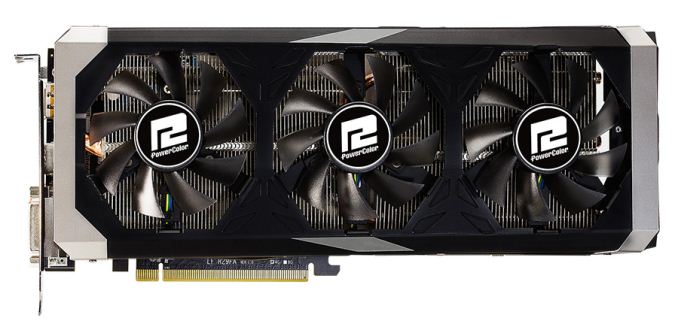
In any case, this guidance gives us little reason to expect that 390’s per-per-watt situation is significantly improved from the 290 series. Consequently, expect to see AMD focus on producing a powerful card and selling it for a good price, as those are the best attributes that AMD can use to promote the 390 series and card sales.
Pricing on the other hand is going to be a mixed bag depending on which direction you’re looking from. As we mentioned a bit ago, AMD’s MSRPs for the 390 series is $329 for the R9 390 and $429 for the R9 390X. These prices essentially put the 390 cards in competition with the GTX 970 and GTX 980, with the R9 390 lining up perfectly with the former, and the R9 390X undercutting the latter by some $70. With the 290 series on the other hand AMD essentially had to price the 290X at GTX 970 levels and the 290 below that, so these 390 series prices represent a significant increase over the 290 series.
Ultimately AMD is banking on the improved performance of the 390 series to justify these higher price tags and allow them to recover on margins. Unfortunately we don’t have any review samples at this time, but if the performance is right then this would be a significant coup for AMD, as it would improve their situation and at the same time put significant new pressure on NVIDIA, which is the kind of situation that AMD thrives in.
One thing AMD won’t have to worry about is the card design situation. With the 290 series AMD shot themselves in the foot with an underperforming reference cooler, and although the underlying chip hasn’t really changed from 290 to 390, leaving card designs entirely in the hands of their partners means that AMD shouldn’t have a repeat of that aspect of the 290 series launch. All of the air-cooled 390 designs will be open air coolers with 2 or 3 fans, and usually the same designs as partners already used for their 290 series cards. Open air coolers do not solve the heat dissipation problem on their own – that 275W of heat needs to go somewhere – but at the very least for AMD it’s going to make for a quieter situation.
Last but certainly not least however, we want to talk a bit more about the performance optimizations AMD has been working on for the 390 series. While we’re still tracking down more details on just what changes AMD has made, AMD had told us that there are a number of small changes from the 290 series to the 390 series that should improve performance by several percent on a clock-for-clock, apples-to-apples basis. That means along with the 20% memory clockspeed increase and 5% GPU clockspeed increase, we should see further performance improvements from these lower-level changes, which is also why we can’t just overclock a 290X and call it a 390X.
So what are those changes? From our discussions with AMD, we have been told that the clock-for-clock performance gains comes from a multitude of small factors, things the company has learned from and been able to optimize for over the last 2 years. AMD did not name all of those factors, but there were a couple of optimizations in particular that were pointed out.
The first optimization is that AMD has gone back and refined their process for identifying the operating voltages of Hawaii chips, with the net outcome being that Hawaii voltages should be down a hair, reducing power and/or thermal throttling. The second optimization mentioned is that the 4Gb GDDR5 chips being used offer better timings than the 2Gb chips, which can depending on the timings improve various aspects of memory performance. Most likely AMD has reinvested these timing gains into improving the memory clockspeeds, but until we get our hands on a 390X card we won’t know for sure.
Shifting gears for a moment to marketing/promotion, expect to see AMD promote the 390 series on the basis of 4K gaming and VR. As far as VR goes there’s a good reason for this, as the R9 290 was the AMD card used in the Oculus Rift recommended hardware specification. So as long as developers stick to Oculus’s recommendations, then the 390 series will deliver the full performance necessary for VR gaming. Meanwhile for 4K gaming, the fact that AMD is promoting the 390 series for 4K is largely a rehash of AMD’s marketing angle from the 290 series, and not unlike the 380, I believe AMD is overshooting, especially as the Fury X should be a far better card for 4K gaming. But we’ll have to see what the performance numbers are like with retail cards.
Finally, to wrap things up we have our standard price comparison table below. Overall, while not every AMD card perfectly maps to an existing NVIDIA card, for the most part AMD is aiming the 300 series to go directly against the bulk of NVIDIA’s 900 series lineup. With the exception of the R9 390X AMD is not attempting to significantly undercut NVIDIA’s pricing, so it will be interesting to see if the performance of these refreshed cards is high enough to give the 300 series the competitive footing it needs. Otherwise AMD will need to deal with the spoiler effect of the 200 series, especially the R9 290X and R9 290.
| Summer 2015 GPU Pricing Comparison | |||||
| AMD | Price | NVIDIA | |||
| Radeon R9 Fury X | $649 | GeForce GTX 980 Ti | |||
| $499 | GeForce GTX 980 | ||||
| Radeon R9 390X | $429 | ||||
| Radeon R9 290X Radeon R9 390 | $329 | GeForce GTX 970 | |||
| Radeon R9 290 | $250 | ||||
| Radeon R9 380 | $200 | GeFroce GTX 960 | |||
| Radeon R7 370 Radeon R9 270 | $150 | ||||
| $130 | GeForce GTX 750 Ti | ||||
| Radeon R7 360 | $110 | ||||
Source : Anandtech com
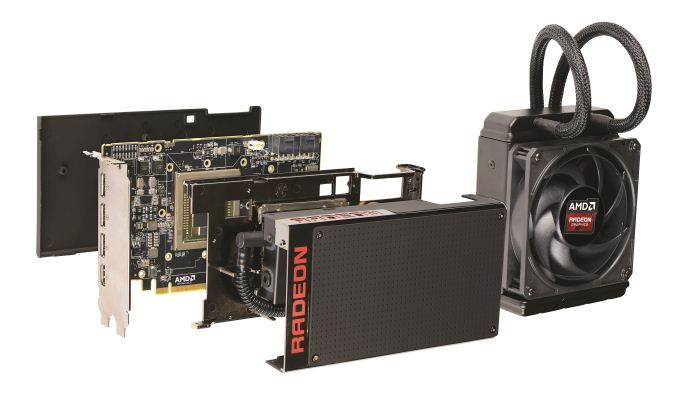
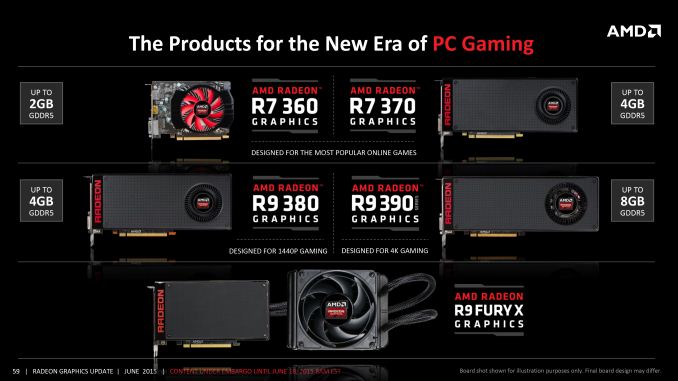
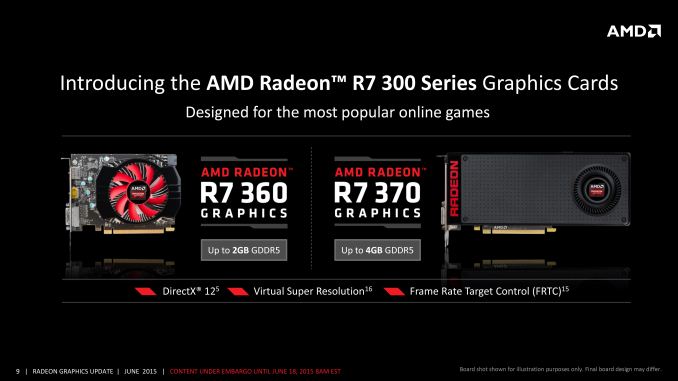

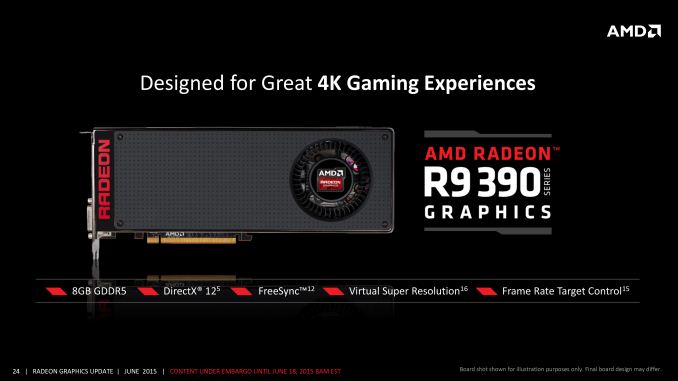

No comments:
Post a Comment